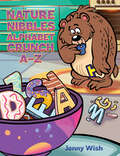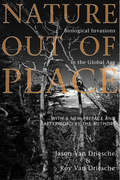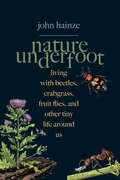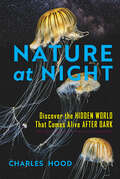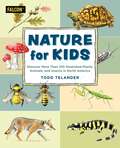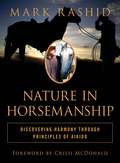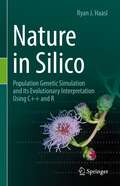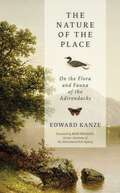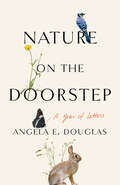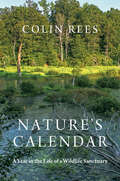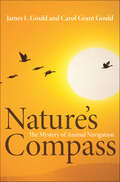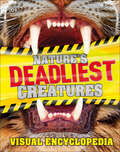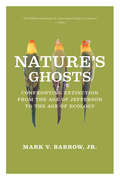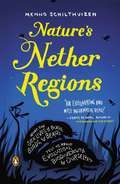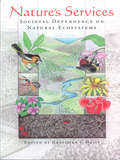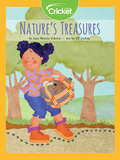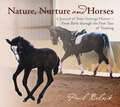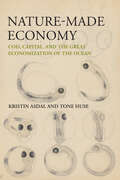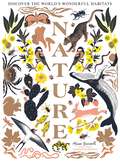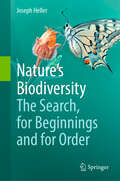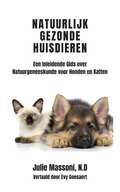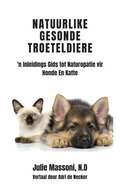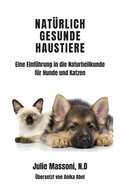- Table View
- List View
Nature Nibbles: Alphabet Crunch A-Z
by Jenny WishNature Nibbles: Alphabet Crunch A-Z celebrates the twist and turn of letters in rhyme. Whimsical and wacky, nature bites their way to unexpected choices. Children will giggle their way in fun while learning the alphabet. This charming little book celebrates unleashed imagination for the early learner and their parents. Nibble away!
Nature Out of Place: Biological Invasions In The Global Age
by Jason Van Driesche Roy Van DriescheThough the forests are still green and the lakes full of water, an unending stream of invasions is changing many ecosystems around the world from productive, tightly integrated webs of native species to loose assemblages of stressed native species and aggressive invaders. The earth is becoming what author David Quammen has called a "planet of weeds." Nature Out of Place brings this devastating but overlooked crisis to the forefront of public consciousness by offering a fascinating exploration of its causes and consequences, along with a thoughtful and practical consideration of what can be done about it. The father and son team of Jason and Roy Van Driesche offer a unique combination of narratives that highlight specific locations and problems along with comprehensive explanations of the underlying scientific and policy issues.Chapters examine Hawaii, where introduced feral pigs are destroying the islands' native forests; zebra mussel invasion in the rivers of Ohio; the decades-long effort to eradicate an invasive weed on the Great Plains; and a story about the restoration of both ecological and human history in an urban natural area. In-depth background chapters explain topics ranging from how ecosystems become diverse, to the characteristics of effective invaders, to procedures and policies that can help prevent future invasions. The book ends with a number of specific suggestions for ways that individuals can help reduce the impacts of invasive species, and offers resources for further information.By bringing the problem of invasive species to life for readers at all levels, Nature Out of Place will play an essential role in the vital effort to raise public awareness of this ongoing ecological crisis.
Nature Underfoot: Living with Beetles, Crabgrass, Fruit Flies, and Other Tiny Life Around Us
by John HainzeAn informed and heartfelt tribute to commonly unappreciated plants, insects, and other tiny creatures that reconsiders humanity&’s relationship to nature Fruit flies, silverfish, dandelions, and crabgrass are the bane of many people and the target of numerous chemical and physical eradication efforts. In this compelling reassessment of the relationship between humans and the natural world, John Hainze—an entomologist and former pesticide developer—considers the fascinating and bizarre history of how these so-called invasive or unwanted pests and weeds have coevolved with humanity and highlights the benefits of a greater respect and moral consideration toward these organisms. With deep insight into the lives of the underappreciated and often reviled creatures that surround us, Hainze&’s accessible and engaging natural history draws on ethics, religion, and philosophy as he passionately argues that creepy crawlies and unwanted plants deserve both empathy and accommodation as partners dwelling with us on earth.
Nature at Night: Discover the Hidden World That Comes Alive after Dark
by Charles HoodA new world awakens in the dark, filled with spectacular bioluminescence, moon-kissed flora, and diverse wildlife—all captured in this spectacular photography book. While old tales warn us that danger lies waiting in the dark, there is actually an abundance of thriving, colorful life. Solar winds brighten the sky with Northern and Southern Lights. In the desert, elegant datura blooms at night, enticing moths to help with pollination, while in the Rockies grizzly bears make a meal of the insects to sustain them during hibernation. In the ocean, night-feeding dolphins chase nocturnal squid which have made a vertical migration to the surface. In the jungles, jaguars hunt by moonlight while night monkeys swing safely through the trees. Experienced naturalist and photographer Charles Hood captures it all, sharing his nocturnal adventures all over the world, with insight, wit, and over 240 stunning photographs. Open your senses to this darkened world, which is strange yet familiar—and more beautiful than you ever imagined.
Nature for Kids: Discovering More Than 100 Illustrated Plants, Animals, and Insects in North America (For Kids)
by Todd TelanderAn illustrated, kid-friendly guide to the magic of natureEmbark on an unforgettable journey with Nature for Kids as celebrated outdoor illustrator and author Todd Telander unveils a curated collection of 101 captivating plants, animals, and insects found across North America. This expertly crafted guide is tailor-made for kids, brimming with vibrant illustrations, engaging activities, and fascinating anecdotes that will ignite a sense of wonder and deepen their understanding of the natural world.With each turn of the page, the captivating illustrations will transport children into the heart of the wilderness, while the interactive activities will spark their curiosity and foster a love for nature. From towering trees to elusive wildlife and delicate winged creatures, this immersive book is the perfect companion for young adventurers seeking to unravel the secrets of the wild.Nature for Kids is more than just a book; it's an invitation to unlock the wonders of our natural heritage. Join the expedition, ignite a lifelong passion for the environment, and empower children with the knowledge to identify and appreciate the incredible biodiversity that surrounds us. Get ready for an awe-inspiring journey that will forever transform the way children see and connect with the world around them.
Nature in Horsemanship: Discovering Harmony Through Principles of Aikido
by Mark Rashid Crissi McdonaldThe popular and highly respected horse trainer Mark Rashid brings together Western and Eastern philosophies to demonstrate a seamless new incarnation of horse training. After years of helping OC difficultOCO horses, Mark Rashid understands how to build the foundation of a horseOCOs training and resolve any problems encountered along the way. He explains how he allows the traditionally firm or assertive approach of the old Western style to take some lessons from the softer conflict resolution and ego reduction approach that the Japanese martial art of aikido teaches. RashidOCOs ultimate goal is for harmony between horse and rider. "
Nature in Silico: Population Genetic Simulation and its Evolutionary Interpretation Using C++ and R
by Ryan J. HaaslDramatic advances in computing power enable simulation of DNA sequences generated by complex microevolutionary scenarios that include mutation, population structure, natural selection, meiotic recombination, demographic change, and explicit spatial geographies. Although retrospective, coalescent simulation is computationally efficient—and covered here—the primary focus of this book is forward-in-time simulation, which frees us to simulate a wider variety of realistic microevolutionary models. The book walks the reader through the development of a forward-in-time evolutionary simulator dubbed FORward Time simUlatioN Application (FORTUNA). The capacity of FORTUNA grows with each chapter through the addition of a new evolutionary factor to its code. Each chapter also reviews the relevant theory and links simulation results to key evolutionary insights. The book addresses visualization of results through development of R code and reference to more than 100 figures. All code discussed in the book is freely available, which the reader may use directly or modify to better suit his or her own research needs. Advanced undergraduate students, graduate students, and professional researchers will all benefit from this introduction to the increasingly important skill of population genetic simulation.
Nature of the Place: On the Flora and Fauna of the Adirondacks
by Edward KanzeA love letter to the Adirondacks, revealing the hidden wonders and interconnected lives of its wildlife by one of the region&’s most prolific and prominent residents.The Nature of the Place is storied Adirondack nature writer Edward Kanze&’s invitation to slow down, smell the roses, and get to know fellow creatures with more longstanding claims to this landscape than we have. Theirs is the real internet, a web of life that weaves together an almost infinite number of threads into a fabric that&’s a wonder to behold and something close to a miracle in a largely hostile universe.In these dazzling pages, readers meet the big charismatic animals of the Adirondacks, the black bear and the moose. We encounter little creatures, too, all of which lead fascinating lives while nearly unseen: tiny fish that live in exquisite mountain streams; the infuriating and almost invisible biting insects called no-see-ums; centipedes; millipedes; and earthworms. Discover an orchid that pays a steep price for its rough treatment of bumblebees; plants so desperate for nitrogen they&’ve taken to catching animals and eating them; poison-ivy and the reasons why we might want to exchange our dislike of it for love; and a common wildflower that goes through serial sex changes. Loons, owls, falcons, eagles, and songbirds pour out effusions of apparent ecstasy here, along with much about bobcats, foxes, snowshoe hares, beavers, and flying squirrels. Snakes, frogs, salamanders, and big predatory fish make appearances also, as well as fungi that produce light in the dark, and bacteria that manipulate the atmosphere to their own advantage, even causing rain and snow to fall.The Nature of the Place is Kanze&’s love letter to his home, the Adirondacks. Gathering materials from his decades-long column at the Adirondack Explorer and elsewhere, extensively revised and rewritten for this book, Kanze&’s singular meditations on the flora and fauna of his home resonate far beyond his own beautiful, beloved, biologically vibrant neck of the woods.
Nature on the Doorstep: A Year of Letters
by Angela E. DouglasNature on the Doorstep reveals the simple pleasures of paying attention to the natural world in one's own backyard over the course of a year. In weekly letters, Angela Douglas shares the joys and curiosities of a decidedly ordinary patch of green in upstate New York cultivated through the art of "strategic neglect"—sometimes taking a hand to manage wildlife, more often letting nature go its own way. From the first flowers of spring to cardinals singing in the winter, Douglas shows us the magic of welcoming unexpected plant and animal life into one's backyard. A paean to the richness we find when we stop to look and let be, Nature on the Doorstep celebrates the role humble backyards play both in conservation efforts and in an expanded appreciation of the living world.
Nature's Calendar: A Year in the Life of a Wildlife Sanctuary
by Colin ReesTake an enchanting journey through the shifting seasons in a wildlife sanctuary home to wetland, forest, and grassland and supporting an incredible diversity of plants and animals.Flocks of waterfowl exploding into steely skies above frozen marshland, salamanders creeping across the forest floor to vernal pools, chorusing frogs peeping their ecstasy while warblers crowd budding trees, turtles sunning on floating logs, the ecological engineering of beavers—these are but a few of the sights and sounds marking a year at Jug Bay Wetlands Sanctuary and its neighboring landscapes in Southern Maryland. In an absorbing account of a year in the life of this sanctuary, naturalist Colin Rees invites us to join him as he explores the secrets and wonders of the changing natural world. Alongside the author, we witness spring's avian migrations, quickening of aquatic vegetation, burgeoning of myriad invertebrates, and the assaults of extreme weather conditions. We revel in summertime's proliferation of fish, fowl, and mammals. We become attuned to the shifting climate's impacts on autumnal transitions, and we marvel at amazing feats of biological inventiveness in preparation for winter conditions. Through these visions of the fleeting—and yet enduring—cycles of nature, Rees shares deep insights into the ecological and behavioral dynamics of the natural environment. Enhanced by more than two dozen color plates, the book touches on a wide range of issues, from microbial diversity, bird banding, and butterfly phenology to genetic diversity and habitat fragmentation. It also examines the challenges of conserving these and other natural features in the face of climate change and development pressures. Thoughtful and lyrical, Nature's Calendar speaks to all readers, scientific and lay alike. Fascinating profiles of flora and fauna celebrate the richness and complexity of a unique ecosystem, exploring the entire ecology of this dynamic and delicate area.
Nature's Compass: The Mystery of Animal Navigation (Science Essentials #16)
by James L. Gould Carol Grant GouldThe mysterious and remarkable ways that animals navigateWe know that animals cross miles of water, land, and sky with pinpoint precision on a daily basis. But it is only in recent years that scientists have learned how these astounding feats of navigation are actually accomplished. With colorful and thorough detail, Nature's Compass explores the remarkable methods by which animals find their way both near home and around the globe. Noted biologist James Gould and popular science writer Carol Gould delve into the elegant strategies and fail-safe backup systems, the invisible sensitivities and mysterious forces, and incredible mental abilities used by familiar and rare species, as they investigate a multitude of navigation strategies, from the simple to the astonishing.The Goulds discuss how animals navigate, without instruments and training, at a level far beyond human talents. They explain how animals measure time and show how the fragile monarch butterfly employs an internal clock, calendar, compass, and map to commence and measure the two-thousand-mile annual journey to Mexico—all with a brain that weighs only a few thousandths of an ounce. They look at honey bees and how they rely on the sun and mental maps to locate landmarks such as nests and flowers. And they examine whether long-distance migrants, such as the homing pigeon, depend on a global positioning system to let them know where they are. Ultimately, the authors ask if the disruption of migratory paths through habitat destruction and global warming is affecting and endangering animal species.Providing a comprehensive picture of animal navigation and migration, Nature's Compass decodes the mysteries of this extraordinary aspect of natural behavior.
Nature's Deadliest Creatures Visual Encyclopedia (DK Children's Visual Encyclopedias)
by DKCome face-to-face with 150 of the world's scariest killer creatures, from the lion and great white shark to the tarantula, anaconda snake, golden eagle, vampire bat, and even the fierce ant!The book profiles every kind of animal--mammals, reptiles, birds, fish, insects, and arachnids. Chapters are arranged according to how these dangerous predators kill. Do they use jaws and claws, venom, stings, traps, tricks and cunning, or mass invasion?With more than 200 spectacular photos in the book, every page has a stunning image of the animal in action, with data files giving a visual guide to its size, distribution, diet, and habitat, as well as a rating of its "scare factor."Each profile features bite-size text that will appeal to all readers. Discover key facts about how the animal lives (is it solitary or a pack animal?), intriguing anatomy (the platypus is famously one of the few venomous mammals, but did you know that the venom comes from the hind leg on the males only?), and of course, their method of attack (such as chasing prey to exhaustion, launching an ambush, or paralyzing with poison).Further fascinating facts can also be found in the reference section at the end of book, including deadly defense, family trees, toxins, and prehistoric deadly creatures that are no more.
Nature's Ghosts: Confronting Extinction from the Age of Jefferson to the Age of Ecology
by Mark V. Barrow Jr.A historical narrative of endangered animals and the dedicated individuals who have studied and struggled to protect them, offering an unprecedented view of what we've lost and a stark reminder of the hard work of preservation still ahead.
Nature's Ghosts: Confronting Extinction from the Age of Jefferson to the Age of Ecology
by Mark V. Barrow Jr.The rapid growth of the American environmental movement in recent decades obscures the fact that long before the first Earth Day and the passage of the Endangered Species Act, naturalists and concerned citizens recognized—and worried about—the problem of human-caused extinction.As Mark V. Barrow reveals in Nature’s Ghosts, the threat of species loss has haunted Americans since the early days of the republic. From Thomas Jefferson’s day—when the fossil remains of such fantastic lost animals as the mastodon and the woolly mammoth were first reconstructed—through the pioneering conservation efforts of early naturalists like John James Audubon and John Muir, Barrow shows how Americans came to understand that it was not only possible for entire species to die out, but that humans themselves could be responsible for their extinction. With the destruction of the passenger pigeon and the precipitous decline of the bison, professional scientists and wildlife enthusiasts alike began to understand that even very common species were not safe from the juggernaut of modern, industrial society. That realization spawned public education and legislative campaigns that laid the foundation for the modern environmental movement and the preservation of such iconic creatures as the bald eagle, the California condor, and the whooping crane.A sweeping, beautifully illustrated historical narrative that unites the fascinating stories of endangered animals and the dedicated individuals who have studied and struggled to protect them, Nature’s Ghosts offers an unprecedented view of what we’ve lost—and a stark reminder of the hard work of preservation still ahead.
Nature's Nether Regions
by Menno SchilthuizenThe story of evolution as you've never heard it before What's the easiest way to tell species apart? Check their genitals. Researching private parts was long considered taboo, but scientists are now beginning to understand that the wild diversity of sex organs across species can tell us a lot about evolution. Menno Schilthuizen invites readers to join him as he uncovers the ways the shapes and functions of genitalia have been molded by complex Darwinian struggles: penises that have lost their spines but evolved appendages to displace sperm; female orgasms that select or reject semen from males, in turn subtly modifying the females' genital shape. We learn why spiders masturbate into miniature webs, discover she dungflies that store sperm from attractive males in their bellies, and see how, when it comes to outlandish appendages and bizarre behaviors, humans are downright boring. Nature's Nether Regions joyfully demonstrates that the more we learn about the multiform private parts of animals, the more we understand our own unique place in the great diversity of life.
Nature's Nether Regions
by Menno SchilthuizenA tour of evolution's most inventive--and essential--creations: animal genitaliaForget opposable thumbs and canine teeth: the largest anatomical differences between humans and chimps are found below the belt. In Nature's Nether Regions, ecologist and evolutionary biologist Menno Schilthuizen invites readers to discover the wondrous diversity of animalian reproductive organs. Schilthuizen packs this delightful read with astonishing scientific insights while maintaining an absorbing narrative style reminiscent of Mary Roach and Jerry Coyne. With illustrations throughout and vivid field anecdotes--among them laser surgery on a fruit fly's privates and a snail orgy--Nature's Nether Regions is a celebration of life in all shapes and sizes. understand our own unique place in the great diversity of life.
Nature's Services: Societal Dependence On Natural Ecosystems
by Stephen Carpenter Gretchen Daily Les Kaufman Kamaljit Bawa Charles H. Peterson Sandra PostelLife itself as well as the entire human economy depends on goods and services provided by earth's natural systems. The processes of cleansing, recycling, and renewal, along with goods such as seafood, forage, and timber, are worth many trillions of dollars annually, and nothing could live without them. Yet growing human impacts on the environment are profoundly disrupting the functioning of natural systems and imperiling the delivery of these services.Nature's Services brings together world-renowned scientists from a variety of disciplines to examine the character and value of ecosystem services, the damage that has been done to them, and the consequent implications for human society. Contributors including Paul R. Ehrlich, Donald Kennedy, Pamela A. Matson, Robert Costanza, Gary Paul Nabhan, Jane Lubchenco, Sandra Postel, and Norman Myers present a detailed synthesis of our current understanding of a suite of ecosystem services and a preliminary assessment of their economic value. Chapters consider: major services including climate regulation, soil fertility, pollination, and pest control philosophical and economic issues of valuation case studies of specific ecosystems and services implication of recent findings and steps that must be taken to address the most pressing concerns Nature's Services represents one of the first efforts by scientists to provide an overview of the many benefits and services that nature offers to people and the extent to which we are all vitally dependent on those services. The book enhances our understanding of the value of the natural systems that surround us and can play an essential role in encouraging greater efforts to protect the earth's basic life-support systems before it is too late.
Nature's Treasures
by Jane Morris UdovicA young girl learns about the wonders of nature in this rhyming poem.
Nature, Nurture and Horses
by Paul BelasikFollow along as four young horses—Corsana, Kara, Elsa, and Escarpa—leave their babyhood behind and begin their training for future careers as sport horses, well schooled in the art of classical dressage.Renowned rider, trainer, author, and equestrian philosopher Paul Belasik shares the daily schedule, weekly events, and his own musings over each horse's character, physicality, athletic ability, and training as the months and seasons pass. Belasik's honest and enlightened journal entries give the reader an inside look at training horses according to the classical system he has used for almost 40 years. His style of writing allows the reader to &“live&” the experiences as he did —
Nature-Made Economy: Cod, Capital, and the Great Economization of the Ocean
by Kristin Asdal Tone HuseAn exploration of the economization of the ocean through the small modifications that enable great transformations of nature.The ocean is the site of an ongoing transformation that is aimed at creating new economic opportunities and prosperity. In Nature-Made Economy, Kristin Asdal and Tone Huse explore how the ocean has been harnessed to become a space of capital investment and innovation, and how living nature is wrested into the economy even as nature, in turn, resists, adapts to, or changes the economy. The authors&’ innovative methodological and conceptual approaches examine the economy by focusing on surprising and numerous &“little tools&”—such as maps and policy documents, quality patrols, and dietary requirements for the enhancement of species&’ biological propensities—that value, direct, reorder, accomplish, and sometimes fail to serve our ends, but also add up to great change.Throughout Nature-Made Economy, Asdal and Huse follow one species, the Atlantic cod, and explore how it is subjected to different versions of economization. Taking this species as a point of departure, they then provide novel analyses of the innovation economy, the architecture of markets, the settling of prices, and more, revealing how the ocean is rendered a space of intense economic exploitation. Through their analysis, the authors develop a distinct theoretical approach and conceptual vocabulary for studying nature–economy relations.Nature-Made Economy is a significant contribution to the broad field of STS and social studies of markets, as well as to studies of the Anthropocene, the environment, and human–animal relations.
Nature: Discover the World’s Wonderful Habitats
by Manon BucciarelliOryx, chanterelle, regale, saguaro, kelp . . . Unlock the secrets of nature's most intriguing inhabitants in a beautifully illustrated voyage across the globe's diverse ecosystems.This stunning book is a captivating exploration of the unique and enchanting species behind these intriguing names. From the vast expanses of the jungle to the serene waters of the lagoon, from the uncharted depths of the abyss to the familiar beauty of an orchard, and through the bustling life of the city to the majestic tranquility of the mountains—embark on a dreamlike adventure across 16 diverse ecosystems.With over 90 plant and animal species to discover, this book offers a fun and interactive learning experience for curious minds of all ages. Each page encouraging readers to guess, search, and find out not only the names of these wonderful species but also the biotopes they inhabit.Journey through these amazing ecosystems and immerse yourself in the beauty, complexity, and interconnectivity of life on our planet. Witness the wonder of nature's creations and foster a deeper appreciation and understanding of our world's precious diversity.
Nature’s Biodiversity: The Search, for Beginnings and for Order
by Joseph HellerThis book is about our quest over the centuries, from ancient Greece onwards, for pattern in the rich diversity of life. How did our ancestors think that living creatures first came to be, each fitting so well to its specific environment? Does biodiversity have a purpose? What biodiversity exists, beyond what our eyes can see? Do dragons and unicorns exist? How did the world begin, how did order emerge and were there several Creation events? Reproduction resembles Creation in that order appears out of nothing, form out of matter. Can different reproduction modes increase biodiversity? Why sexual reproduction? Can living creatures, and hence biodiversity, arise from non-living dust? How do embryos develop, from a featureless mass into an orderly, organised living body? Does embryonic development dictate diversity and do species ever go extinct? What is a soul? Do animals have souls? Do souls migrate, between man and animal? Does inheritance of acquired characters create biodiversity? Does diversity form an orderly ladder from plants through animals to Man, or perhaps orderly circles-within-circles? These questions and many others have been central to our culture&’s overall view of nature, from ancient times onwards. This book, presenting the urge to understand overall pattern in the diversity of life throughout history, takes a broad approach. It links theories of classification with those of reproduction, embryology, theology and (eventually) evolution, as they developed from ancient days onwards, over 2400 years. Over 250 illustrations accompany the text, many taken from the ancient, original treatises, many others painted especially for this book, to present specific animals or ideas. This comprehensive view of the study of biodiversity will appeal to zoology lecturers and students, biology teachers and amateur naturalists, as well as to lecturers and learners of history, of theology; and of course, to anybody seeking to broaden horizons.
Natuurlijk Gezonde Huisdieren - Een Inleidende Gids over Natuurgeneeskunde voor Honden en Katten
by Julie MassoniNatuurlijk Gezonde Huisdieren is een inleidende gids over natuurgeneeskunde voor honden en katten. Hij bevat informatie over natuurlijke voeding en voedingssupplementen om de gezondheid van je dieren te verbeteren, alsook informatie over het gebruik van kruiden, homeopathie en Bachbloesems, om gezondheid en welzijn te bevorderen. Ook natuurlijke alternatieven voor vlooienbestrijding, ontworming, antibiotica en pijnbestrijding komen aan bod. Deze gids bevat eveneens informatie over het voeren van een vegetarisch dieet aan honden. Geschreven door een gekwalificeerd Veterinair Natuurgeneeskundige, die duizenden dieren met een waaier aan acute en chronische gezondheidsproblemen heeft geholpen. Als je meer wil weten over het gebruik van natuurlijke therapieën en hoe je veel gezondheidsproblemen kan voorkomen, dan is dit boek een uitstekende referentie.
Natuurlike Gesonde Troeteldiere - ‘n Inleidings Gids tot Naturopatie vir Honde En Katte
by Julie Massoni Vertaal deur Adri de NeckerNatuurlike Gesonde Troeteldiere is ‘n inleidings gids tot naturopatie vir honde en katte en sluit inligting in oor ‘n natuurlike dieet, voedings aanvullings om jou dier se gesondheid te verbeter asook inligting oor die gebruik van kruie, homeopatie en blom ekstrakte om te help met gesondheid en welstand. Natuurlike alternatiewe vir vlooie, ontwurming, antibiotikas en pyn verligting. Sluit ook inligting in oor die voer van ‘n vegetariese dieet vir honde. Geskryf deur ‘n gekwalifiseerde dier naturopaat wat al duisende diere gehelp het wat ‘n reeks van akuut en chroniese gesondheids toestande het. As jy daarvan sal hou om meer te weet oor die gebruik van natuurlike terapie en hoe om baie gesondheids probleme te vermy, dan is hierdie boek ‘n goeie verwysing.
Natürlich gesunde Haustiere
by Julie Massoni A. M. A.Natürlich gesunde Haustiere ist eine Einführung in die Naturheilkunde für Hunde und Katzen und beinhaltet Informationen über natürliche Ernährung und Nahrungsergänzungsmittel, um die Gesundheit Ihres Tieres zu verbessern. Ebenso enthalten sind Informationen zur Anwendung von Käräutern, Homöopathie und Blütenessenzen zur Unterstützung von Gesundheit und Wohlbefinden. Es werden natürliche Alternativen zur Behandlung von Floh- und Wurmbefall, Alternativen zu Antibiotika und zu Schmerzmitteln vorgestellt und Informationen über die vegetarische Ernährung von Hunden vermittelt. Es handelt sich um ein Buch, das von einer qualifizierten Tierheilpraktikerin geschrieben wurde, die schon tausenden von Tieren mit einer Reihe akuter und chronischer Erkrankungen helfen konnte. Wenn Sie mehr über die Verwendung natürlicher Therapiemethoden und die Vermeidung vieler Gesundheitsprobleme erfahren möchten, dann ist dieses Buch eine großartige Wahl.
